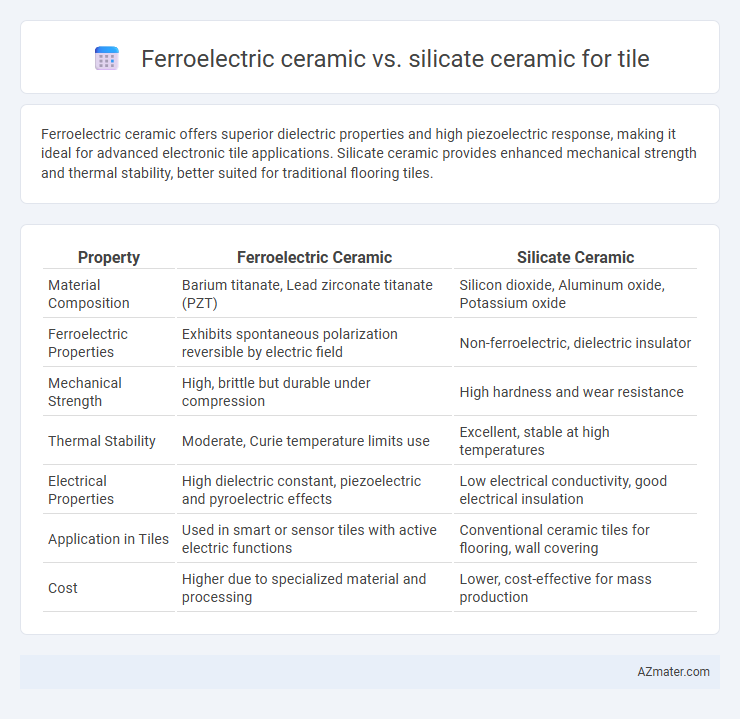Ferroelectric ceramic offers superior dielectric properties and high piezoelectric response, making it ideal for advanced electronic tile applications. Silicate ceramic provides enhanced mechanical strength and thermal stability, better suited for traditional flooring tiles.
Table of Comparison
| Property | Ferroelectric Ceramic | Silicate Ceramic |
|---|---|---|
| Material Composition | Barium titanate, Lead zirconate titanate (PZT) | Silicon dioxide, Aluminum oxide, Potassium oxide |
| Ferroelectric Properties | Exhibits spontaneous polarization reversible by electric field | Non-ferroelectric, dielectric insulator |
| Mechanical Strength | High, brittle but durable under compression | High hardness and wear resistance |
| Thermal Stability | Moderate, Curie temperature limits use | Excellent, stable at high temperatures |
| Electrical Properties | High dielectric constant, piezoelectric and pyroelectric effects | Low electrical conductivity, good electrical insulation |
| Application in Tiles | Used in smart or sensor tiles with active electric functions | Conventional ceramic tiles for flooring, wall covering |
| Cost | Higher due to specialized material and processing | Lower, cost-effective for mass production |
Introduction to Ceramic Tiles
Ferroelectric ceramics exhibit unique electrical properties, making them ideal for smart tile applications requiring responsiveness and energy efficiency, whereas silicate ceramics dominate traditional tile manufacturing due to their excellent durability, chemical resistance, and thermal stability. Silicate ceramic tiles, primarily composed of silica and alumina, offer superior hardness and are widely used in residential and commercial flooring. The choice between ferroelectric and silicate ceramics depends on functional requirements, with ferroelectric ceramics suited for advanced technological integrations and silicate ceramics favored for structural reliability and cost-effectiveness.
Overview of Ferroelectric Ceramics
Ferroelectric ceramics, characterized by their spontaneous electric polarization reversible by an external electric field, exhibit unique dielectric, piezoelectric, and pyroelectric properties that make them valuable in advanced electronic and sensor applications. Compared to silicate ceramics used for tiles, ferroelectric ceramics possess higher dielectric constants and improved electromechanical coupling, enabling functionalities beyond mere structural use. Their crystal lattice structure, often perovskite-type such as barium titanate or lead zirconate titanate, allows manipulation of electric dipoles, distinguishing them fundamentally from the primarily insulating and mechanically robust silicate ceramics.
Understanding Silicate Ceramics
Silicate ceramics, composed primarily of silicon dioxide combined with various metal oxides, offer excellent thermal stability and chemical resistance, making them ideal for tile applications in high-temperature or corrosive environments. Unlike ferroelectric ceramics, which exhibit unique electric polarization properties, silicate ceramics provide superior hardness and abrasion resistance, ensuring durable and long-lasting tile surfaces. Their microstructure promotes low porosity, enhancing moisture resistance and making silicate ceramic tiles highly suitable for both indoor and outdoor use.
Material Composition Comparison
Ferroelectric ceramics primarily consist of perovskite-structured materials like lead zirconate titanate (PZT), featuring a crystalline arrangement that exhibits spontaneous polarization and high dielectric constants. Silicate ceramics are chiefly composed of silicate minerals such as kaolinite, feldspar, and quartz, forming a glassy or crystalline matrix that offers durability and chemical stability for tiles. The key material composition difference lies in ferroelectric ceramics having complex oxide compositions with functional electric properties, whereas silicate ceramics are dominated by silica-based compounds tailored for mechanical strength and surface finish.
Mechanical Properties and Durability
Ferroelectric ceramics exhibit superior mechanical strength and resistance to fatigue due to their domain wall movements, making them more resilient under cyclic stresses compared to silicate ceramics, which are generally more brittle and prone to fracture. The intrinsic piezoelectric properties of ferroelectric ceramics enhance their durability in applications subjected to vibration and mechanical load. Silicate ceramics offer good hardness and thermal stability but lack the toughness and impact resistance required for high-durability tile applications in demanding environments.
Electrical and Thermal Characteristics
Ferroelectric ceramics exhibit high dielectric constants and excellent piezoelectric properties, making them ideal for sensors and actuators in tile applications requiring electrical responsiveness. Silicate ceramics offer superior thermal stability and resistance to thermal shock, providing enhanced durability under high temperature fluctuations. Their lower dielectric constant compared to ferroelectric ceramics limits electrical applications but ensures better insulation and heat resistance in tile installations.
Aesthetic and Design Versatility
Ferroelectric ceramics offer vibrant color options and unique surface textures due to their polarized domains, enhancing aesthetic appeal in tile design. Silicate ceramics provide a wide range of natural hues and intricate patterns inspired by mineral compositions, lending classic elegance and versatility for various interior styles. Both materials accommodate advanced printing techniques, but ferroelectric ceramics excel in dynamic light-reflective effects, while silicate ceramics maintain timeless visual consistency.
Installation and Maintenance Considerations
Ferroelectric ceramics offer superior durability and stability, making tile installation more reliable with less risk of warping or cracking under stress compared to silicate ceramics. Silicate ceramic tiles typically require more careful handling and frequent maintenance due to their higher porosity and susceptibility to moisture damage. Maintenance of ferroelectric ceramic tiles is generally lower, benefiting from their enhanced resistance to stains and wear, which reduces long-term cleaning and repair efforts.
Cost Analysis and Market Availability
Ferroelectric ceramics generally come with higher production costs than silicate ceramics due to their complex material composition and specialized manufacturing processes, making them less economically viable for mass tile production. Silicate ceramics dominate the tile market thanks to their abundant raw materials, lower costs, and well-established supply chains that ensure widespread availability. Market availability heavily favors silicate ceramic tiles, which are widely produced and distributed globally, whereas ferroelectric ceramic tiles remain niche products with limited commercial presence.
Application Suitability: Ferroelectric vs. Silicate Tiles
Ferroelectric ceramic tiles demonstrate superior application suitability in environments requiring enhanced dielectric properties, making them ideal for sensors, actuators, and energy harvesting surfaces. Silicate ceramic tiles excel in structural applications due to their excellent mechanical strength, thermal stability, and chemical resistance, commonly used in construction and decorative wall cladding. Choosing between ferroelectric and silicate ceramic tiles depends on the specific application demands for electrical functionality versus mechanical durability.

Infographic: Ferroelectric ceramic vs Silicate ceramic for Tile
 azmater.com
azmater.com